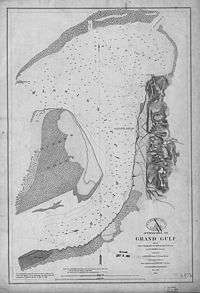Battle of Grand Gulf
| ||||||||||||||||||||||||||||||||||
The Battle of Grand Gulf was fought on April 29, 1863, during the American Civil War. In the Vicksburg Campaign of Maj. Gen. Ulysses S. Grant, Union naval forces under Rear Adm. David D. Porter led seven ironclads in an attack on the Confederate fortifications and batteries at Grand Gulf, downriver from Vicksburg, Mississippi. Although the Confederates withstood the Union bombardment and prevented infantry from landing against their fortification, the defeat was only a minor setback to Grant's plan to cross the Mississippi River and advance against Vicksburg.
Background
In the summer of 1862 Confederate field artillery had periodically harassed naval vessels from Grand Gulf. The town was largely burned in 1862 during bombardment and raids as the Federals attempted to suppress construction of earthworks around the town. However, construction of Confederate batteries with heavy artillery resumed in March 1863.[2]
The primary works at the time of the April 1863 battle were two earthen forts, Fort Cobun and Fort Wade. Atop Point of Rock, Fort Cobun was the stronger fortification due to its elevation and its parapet, 40 feet thick. Fort Wade sat only 20 feet above the river, approximately three quarters of a mile downstream and a quarter of mile from the water's edge. Rifle pits ran along the ridge connecting the two works.[3]
Battle

Admiral Porter led seven ironclad river gunboats in an attack on the fortifications and batteries at Grand Gulf, Mississippi, with the intention of silencing the Confederate guns and then securing the area with troops of Maj. Gen. John A. McClernand's XIII Corps who were on the accompanying transports and barges. The attack by Benton, Lafayette, Tuscumbia, Carondelet, Louisville, Mound City, and Pittsburgh began at 8 a.m. and continued until about 1:30 p.m. During the fight, the armored vessels moved within 100 yards of the Confederate guns at Fort Cobun. The union gunboats successfully silenced the lower batteries of Fort Wade, but the upper batteries at Fort Cobun remained out of reach and continued to fire.
The Union ironclads (one of which, the Tuscumbia, had been put out of action) and the transports drew off. After dark, however, the ironclads engaged the Confederate guns again while the steamboats and barges ran the gauntlet.
Aftermath
Grant marched his men overland across Coffee Point to below the Gulf. After the transports had passed Grand Gulf, they embarked the troops at Disharoon's plantation and disembarked them on the Mississippi shore at Bruinsburg, below Grand Gulf. The men immediately began marching overland toward Port Gibson, Mississippi. The Confederates had won a hollow victory; the loss at Grand Gulf caused just a slight change in Grant's offensive.
Notes
References
- Ballard, Michael B. Vicksburg, The Campaign that Opened the Mississippi. Chapel Hill: University of North Carolina Press, 2004. ISBN 0-8078-2893-9.
- Bearss, Edwin C. The Campaign for Vicksburg. Vol. 2, Grant Strikes a Fatal Blow. Dayton, OH: Morningside House, 1986. ISBN 0-89029-313-9.
- Wright, William C. Archaeological Report No. 8: The Confederate Magazine at Fort Wade Grand Gulf, Mississippi, Excavations 1980-1981. Mississippi Department of Archives and History, 1982.
- National Park Service battle description
- CWSAC Report Update
